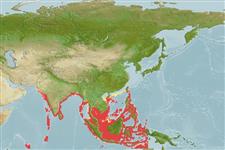Common names from other countries
Environment: milieu / climate zone / depth range / distribution range
Ecologia
marinhas associadas(os) a recifes. Tropical; 24°N - 12°S, 59°E - 133°E (Ref. 55)
Indian Ocean: Zanzibar, Seychelles and Madrakah, southern Oman; up to Sri Lanka, and India. Formerly confused with Lutjanus xanthopinnis known from the Indo-West Pacific region.
Tamanho / Peso / Idade
Maturity: Lm ? range ? - ? cm
Max length : 30.0 cm TL macho/indeterminado; (Ref. 55); common length : 20.0 cm TL macho/indeterminado; (Ref. 55)
Espinhos dorsais (total): 10; Raios dorsais moles (total): 13; Espinhos anais 3; Raios anais moles: 9. This species is distinguished by the following characters: no scales on the preopercular flange; scales on the cheek 7-8 rows; with a rounded posterior nostril; predorsal scales extending to about the level of the posterior edge of the orbit; with a prominent mid-lateral yellow stripe, from 1.5 to 3 scale rows wide (Ref. 106991).
Adults inhabit coral and rocky reefs (Ref. 55) in coastal areas and outer slopes.
Life cycle and mating behavior
Maturidade | Reprodução | Desova | Ovos | Fecundidade | Larvas
Iwatsuki, Y., F. Tanaka and G.R. Allen, 2015. Lutjanus xanthopinnis, a new species of snapper (Pisces: Lutjanidae) from the Indo-west Pacific, with a redescription of Lutjanus madras (Valenciennes 1831). J. Ocean Sci. Found. 17:22-42. (Ref. 106991)
Categoria na Lista Vermelha da IUCN (Ref. 130435)
CITES (Ref. 128078)
Not Evaluated
Ameaça para o homem
Harmless
Utilização humana
Pescarias: espécies comerciais
Mais informação
Nomes comunsSinónimosMetabolismoPredadoresEcotoxicologiaReproduçãoMaturidadeDesovaFecundidadeOvosDesenvolvimento dos ovos
ReferênciasAquaculturaPerfil para aquaculturaEstirpesGenéticaElectrophoresesHereditariedadeDoençasProcessamentoMass conversion
ColaboradoresFotografiasStamps, Coins Misc.SonsCiguateraVelocidadeTipo de nataçãoÁrea branquialOutras referênciasCérebrosVisão
Ferramentas
Relatórios especiais
Descarregue XML
Fontes da internet
Estimates based on models
Preferred temperature (Ref.
115969): 27.3 - 29.2, mean 28.6 (based on 1038 cells).
Phylogenetic diversity index (Ref.
82804): PD
50 = 0.5000 [Uniqueness, from 0.5 = low to 2.0 = high].
Bayesian length-weight: a=0.01479 (0.00706 - 0.03101), b=2.97 (2.81 - 3.13), in cm Total Length, based on LWR estimates for this Genus-body shape (Ref.
93245).
Nível Trófico (Ref.
69278): 3.8 ±0.6 se; based on size and trophs of closest relatives
Resiliência (Ref.
120179): Médio, tempo mínimo de duplicação da população 1,4 - 4,4 anos (Preliminary K or Fecundity.).
Fishing Vulnerability (Ref.
59153): Low vulnerability (20 of 100).
